Soulstice Searching
Out of everyone I know, I seem to be the only one who actively considers the Solstices. The Summer and Winter Solstices, which occur between 20th and 22nd of June and December, respectively, mark the official start of those seasons (regardless of what your vacation calendar would have you believe). Thanks to the elliptical orbit of the earth, they are also the days on which the Earth receives the most and least sunlight. They are literally the high and low points of the year.
As such, the Winter Solstice marks a time for reflection: reflection of one’s goals and on one’s actions (like those times you played Kantai Collection during meetings, when you secretly enjoyed watching Ore Twintail ni Narimasu, that one Toonami-related Sporkle quiz you failed, CONFESS!!!). But it’s also a time for celebration, and today, we recall the Top 5 Most Memorable Anime of 2014. Why only the Top 5? Because the annals of time (as well as your ADD-riddled mind) will only remember the shows and experiences that most deeply touched you in any given year, and on this given year, there are exactly 5 shows that made the cut.
But first, some ground rules:
-
“Memorable” ≠ “Good” – Again, we’re dealing with high and low points here.
-
Anime is considered based on the air date of its FINAL episode – This is what leaves me particularly torn. This rules alone practically rigs next year’s list. I guess 2015’s anime is going to have to step up or shut up.
-
Anime with multiple scheduled seasons/series are only considered on the year of the final episode of the final season/series. – I’m looking squarely at you two, -monogatari and Grisaia.
With that understanding, this is the year that was.
5. Psycho-Pass 2

And suddenly the Crime Coefficient of the entire reader base spikes.
Gen Urobuchi’s been on a roll lately. Whether he’s writing the most expensive anime prequels, deconstructing the magical girl genre, or making some entertaining mecha, everyone this guy touches practically turns to gold. The same was true for a little Production I.G. project called Psycho-Pass. Set 100 years in the future, the psychological action thriller follows the security force that acts as judge, jury, and executioner over the souls of a technocratic Japanese society. Despite its less-than-brilliant explanation of the Sibyl System that rules over this “enlightened” future, the show was a huge hit with Eastern and Western audiences. So when Production I.G. announced the sequel, Psycho-Pass 2, everyone was more than a little excited.
Everyone except Gen Urobuchi, that is. In fact, the only thing he contributed to Psycho-Pass 2 was the Story Concept (i.e. Psycho-Pass). And so, the problem was two-fold: massive hype for I.G.’s most popular franchise since Ghost in the Shell and the fact that Urobochi’s Midas Touch only lasts as long as he is still touching. In the beginning, things were good. Fans loved watching Inspector Tsunemori be promoted to Major Kusanagi, and for a short time, it looked like the sequel would meet their lofty expectations. But then the show went to some dumb places, then some stupid places, then some really stupid places, and then it went to Sibyl.
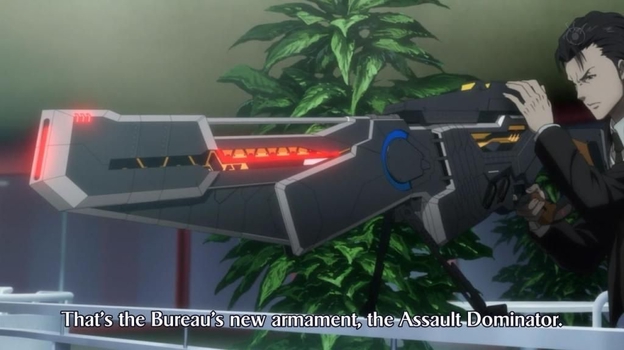
And who could forget the Assault Dominator?
Fans weren’t disappointed. They were outraged. This was a show that supposedly had standards (something, something, People must protect the Law). Apparently, I.G. saw it fit to not only lower the bar, but to remove the floor entirely. Ultimately, Psycho-Pass 2 will remain in your memories the same way that the second arc of Sword Art Online did: a relatively good show crushed by comically inferior storyline, execution, and purpose. If ever 2014 had a low point, this was most certainly it.
4. Selector Infected/Spread – WIXOSS
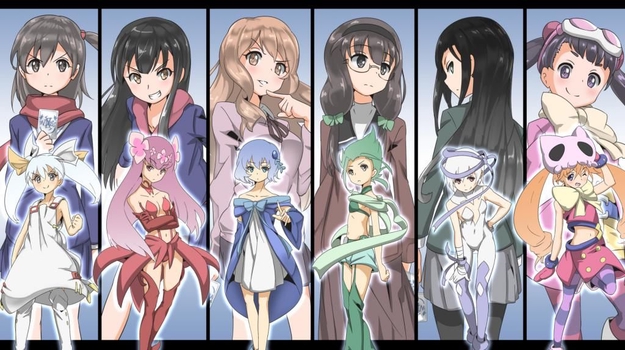
What is your wish, Selector?
This fucking show…this show right here…
One day, a lonely girl named Ruu is given a starter deck of cards for a CCG called WIXOSS (pronounced “we-cross,” not “weak-sauce”) by her grandmother, who, for some reason, played WIXOSS first. Upon opening the box, she encounters a very special card called an Lrig (which is a young girl actually existing inside the card), thus making Ruu a Selector. The Lrig inside, who Ruu bestows the name Tama, is meant to help Ruu fulfill whatever wish her little heart desires. But certain “conditions” must first be met, and they typically center around defeating other Selectors in a highly dub-stepped WIXOSS battle. Of course, non-Selectors cannot see or interact with Lrigs, nor can they witness Selector battles, so it’s all very secretive.
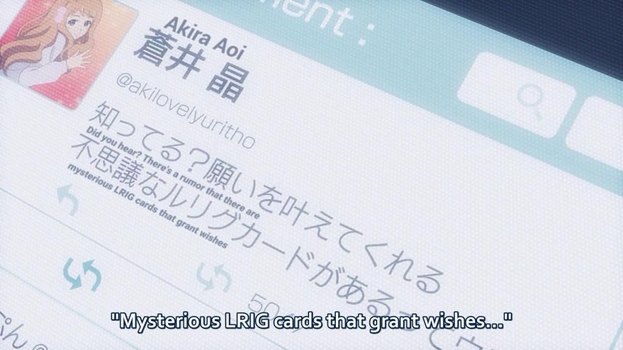
Except when you post it on social media.
But Selectors must be careful not to lose 3 times. The penalty for that is not only having their wish never come true, but even reversed (yeah, these folks play hardball). However, “winning” at WIXOSS isn’t much better. For when the conditions have been met, the Lrig is promoted to “Eternal Girl,” and the Selector wins a meet and greet with Mayu, Master of Lrigs and entrapment as an Lrig herself, all while the Eternal Girl inhabits the girl’s body and is charged with ensuring that the original wish comes true – or else they themselves will cease to exist. So the only way to get out of the card is to help another girl win her Selector battles, thus trading bodies and dooming someone else, while still being forced to live out another girl’s life and her dreams.
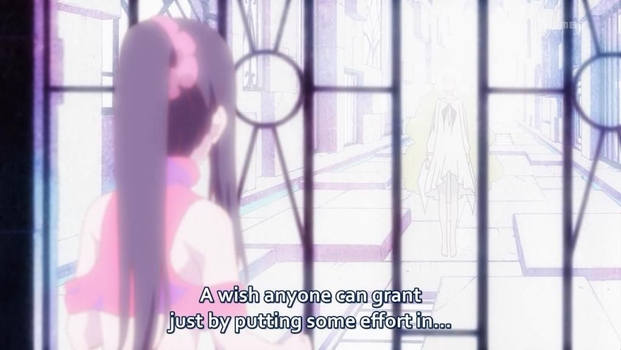
Yes! How many times, HOW MANY TIMES did I tell you all, “YES!”
Confused? You should be. And up until the first season finale, so was I. The “conditions” are intentionally vague, the rules to the WIXOSS game are never clarified (even after several battles), the consequences of winning and losing WIXOSS battles are constantly being broken, the system itself is incredibly rickety, and the system is entirely sustained by the absolute selfishness of everyone involved. It’s the anime equivalent of a Ponzi-scheme. Then it all made sense. The melodrama, the silliness, the terribly storytelling, all done with a completely straight face. This is a damn troll show.
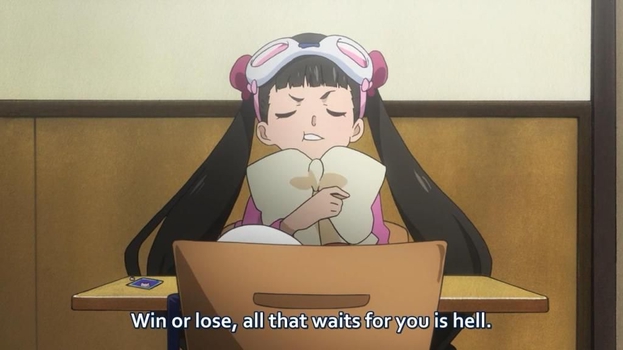
This Troll Shoujo gets it.
And once it’s treated as one big troll show, then it becomes hilarious. Cruelly, painfully hilarious. And you’d best be in that mindset for the second season, because after the worst show gets the best first season finale, no one is spared from the trolling, not even Mayu.

Except Ulith. That bitch is having the time of her life.
The show may not (i.e. definitely not) have much going for it except the troll factor, but for doing such a thorough job of it and completely upending viewer expectations, WIXOSS earns its place as a truly memorable anime in 2014.
3. Ping Pong – The Animation
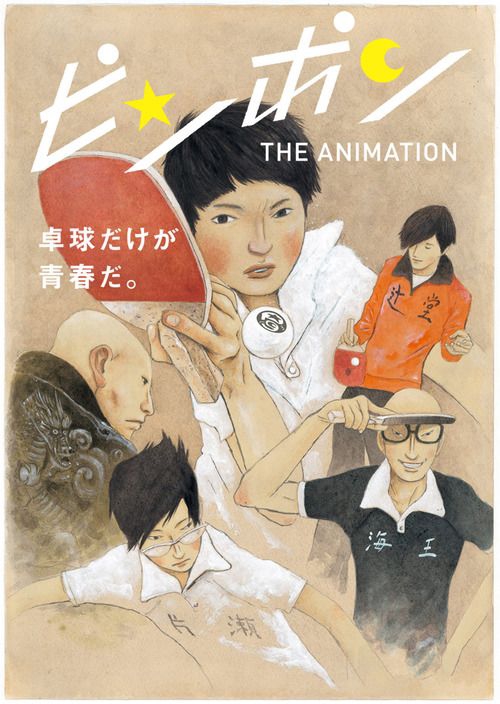
ENTER THE HERO!
If you’ve never heard of Tatsunoko Production, few people would ever fault you. Despite being one of the oldest anime studios still in existence (second only to Toei Animation), it’s kept a pretty low profile. While Toei focused on movies, Tatsunoko produced some of the most famous TV shows of yesteryear, including Speed Racer and Macross (yes, the original Macross). Seeing as their most recent noteworthy successes were Casshern Sins and [C], I figured I’d give their latest show Ping Pong a shot. Oh wow, did they nail it.
Ping Pong is about the high school ping pong career of childhood friends Makoto “Smile” Tsukimoto and Yukata “Peco” Hoshino. They both excel at the sport, although Smile has worked hard to reach the point that Peco has gotten to with talent alone. After a new Chinese transfer student named Kong Wenge arrives at a rival high school, Peco challenges the new guy to a match. However, Kong used to play on the top team in China, but a twist of fate has forced him to play as a ringer in Japan. While Kong unilaterally crushes Peco, he curses his fate that he is left without any challenge here. The match would prove an seminal one, causing Peco to stop practicing, and the friends’ coach to commit to unlocking Smile’s hidden potential.
Ping Pong is abrasive in just about every dimension. Its animation, its characters, its storytelling, and its subject all work to test the patience of the average anime viewer. Of all the subjects that anime allows one to experience, of all the sports anime, the humble sport of competitive ping pong hardly appears at first glance to be one worth appreciating. Rest assured, you don’t need death matches and Christopher Walken to enjoy this. But I won’t lie, the animation is an acquired taste. If you thought The Flowers of Evil (aka “The Ultra-Budget”) was difficult to watch, you’d best move along. It’s not that the show is cheap or poorly drawn, but it’s style of animation is an incredibly rough one, filled with deformed character shots, ugly faces, and messy lines (I dare you to find a single clean, straight line in the entire show). But it’s got style, none the less. Its camera work is where the animation really finds its strong footing. Action shots, close-ups, angled wide shots, double-takes, and some really creative use of split-screens and zooming give the anime a unique feel.
The characters are tough to appreciate, too. Smile (who ironically never smiles) is quiet and dull, or rather he has a quiet intensity that only comes out when he plays. Meanwhile, his long-time friend Peco is obnoxious and his natural talent for the game is so high that he rarely ever practices. Neither make for initially compelling characters.

Go back to TryHard State!
But the show has a spirit about it, a spirit I haven’t seen since Chihayafuru (and I’m not just talking t-shirts). In fact, the storytelling feels a lot like Chihayafuru, and the central dichotomy is all too familiar. If you have a talent for something, how long should you continue down that path? Until there’s a challenge? Until you have to practice to get better? Until it’s no longer fun? Until you’re the best? If nothing interests you, is it better to stick to what you’re inherently good at, or to find something else to work towards? These questions are central to any specialized athlete, but they’re even more essential to someone who may not want to be one. Failure can be a very painful thing when you believe that you’re very good at something, but it can be devastating to someone who has invested their life in becoming an automaton who is focused on being the best at something so narrow. Of course, the opposite is also true. Those who have invested so much only to be confronted with no challenge face their own kind of torment. Again, this is the price to be paid for highly specialized human development. Overcoming such dilemmas allows athletes to reach their greatest potential.
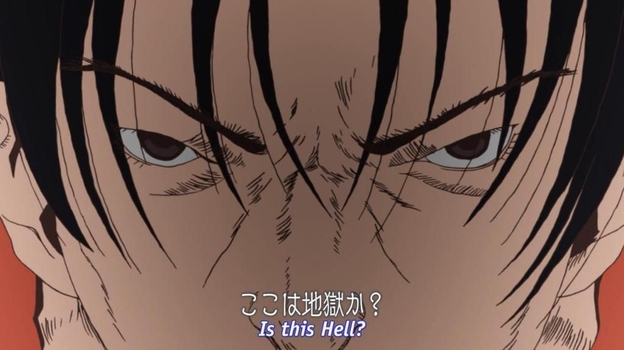
この地獄はありますか?
I’m one of the least likely people to watch a major sporting event in real life, but Ping Pong is one of those shows that comes along and makes me wonder, just a little, whether I might be missing out on something. However, those who aren’t missing out on anything would certainly be remiss to have dismissed such a show as this.
2. KILL la KILL
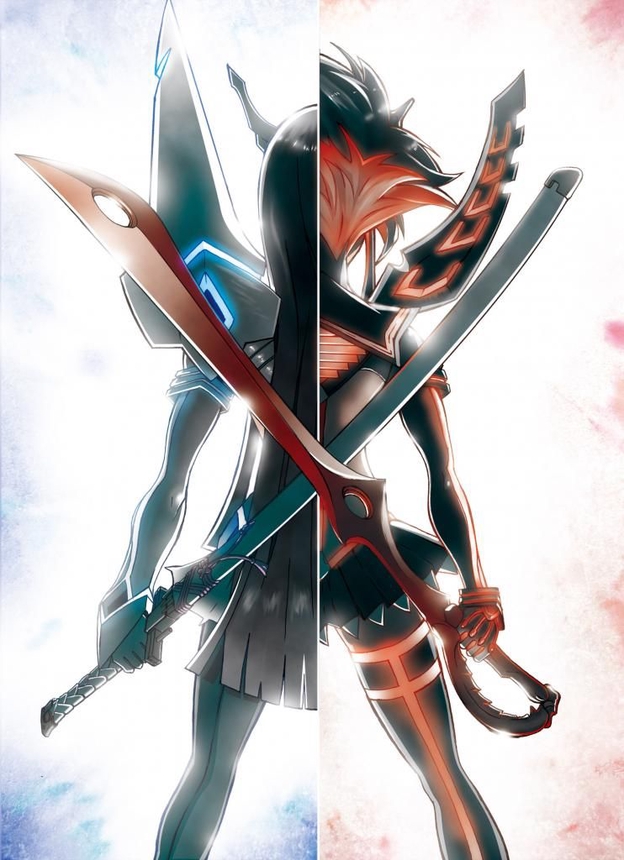
Dressed to KILL
In 2007, Gainax director Hiroyuki Imaishi was riding pretty high. Following his successes with Abenobashi in 2002 and the critically acclaimed Dead Leaves in 2004, Imaishi had just completed his most ambitious project to date: Gurren Lagann. The widespread love for Simon, the humble underground digger who would one day liberate the human race (and indeed all sentient life) from universal oppression has cemented the series as one of the highest-rated anime of all time (remaining in the ANN Top 100 to this day). The problem is, a story culminating in a grand battle for the fate of the universe is a tough act for a studio to follow. So to circumvent this issue, in 2011 Imaishi took his top animators and started their own studio, Trigger.

With gambling, and hookers!
KILL la KILL is the tale of Ryuuko Matoi and her pursuit of vengeance against whoever murdered her scientist father with a giant scissor blade. That path has lead her to the prestigious and highly militarized Honnouji Academy, the very embodiment of high school dominance, and its all-powerful student council president, Satsuki Kiryuuin. The school and the town that it governs are arranged in a caste system that is determined by strength and school standing. Those of the upper echelons are bestowed Ultima Uniforms by President Kiryuuin, which grant the wearer truly super-human abilities. The source of strength for these Ultima Uniforms are the mysterious Life Fibers, and the higher the thread count, the more powerful the Uniform (1 Star = 10%, 2 Star = 20%, 3 Star = 30%).
In order to get some answers, Ryuuko picks a fight with Satsuki, but that means having to fight her way through the entire student body first, including Best Character Ira Gamagoori. Along the way, Ryuuko befriends her nudist-enthusiast homeroom teacher, Second Best Character Mako Mankanshoku, and the final creation of Ryuuko’s father: a legendary Godrobe named Senketsu, made of 100% Life Fibers.
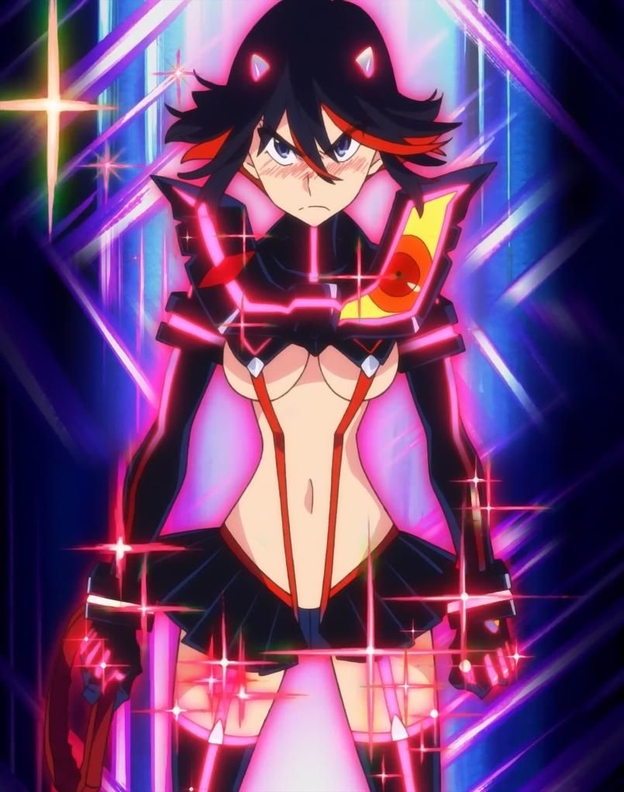
Plus it doubles as really kinky lingerie.
Training arcs and hilarity ensue, but after the first act, things accelerate pretty quickly. From there, new bosses are revealed, plots get twisted, and thoroughly confusing screenshots are posted, all leading up to a final showdown against evil space fabric plotting world domination. This is Imaishi we’re talking about. No questions!
KILL la KILL is what you would call “special” in modern anime. By “special,” I mean that it is a completely original story with an original score with an original art style. That combination is surprisingly rare, especially in a year when the top animation studios are preoccupied with adaptations. Even more rare are the interactions between the characters in this show. Trigger went to great lengths to craft a carefully choreographed madness to its world, one where high schools wage all-war and nudist colonies fight Reebok for the fate of humanity. The soundtrack is a blast (sometimes literally), and the animation is distinctly Imaishi’s own. The vibrant colors, imposing structures, and truly bombastic fights bring the show (and its clothing) to life. Even the classic Japanese block font is physically manifested throughout the show.
In particular, I’d like to point out Best Couple Mako and Ira. While clearly being two ships passing in the night, never before have I seen such manic characters so perfectly on the same emotional wavelengths at all times. Supporting characters rarely shine so brightly, and to see both of them light up whatever scene they are separately in is always an entertaining experience (let alone both being in the same space – they always seem to only be together outside somewhere).
Speaking of animation and character designs, KILL la KILL employs an intriguing technique to save budget and exploit comedic value: cheap animation. Now, I don’t mean that the show skimps on frames, or that the style gets shoddy in places. I mean it takes a scene (oddly enough, it’s typically a fight scene), and just starts making the characters movements look cheap. No more aggravating/hilarious is this used than with worst character Harime Nui, the Grand Couturier. Her entire character is designed to act as budget as possible, ranging from gif action to Paper Mario fighting styles. She makes The Flowers of Evil look like Another. And the gifs. Need I even talking about them? The show practically goes out of its way to provide a new wonderful gif every single week.

Truly, the gif that keeps on gif-ing.
KILL la KILL continues Hiroyuki Imaishi’s long-standing record of projects that defy all expectations. For once, we have an outstanding anime where the clothes make the show.
And the most memorable animated series of 2014 is….
1. No Game, No Life
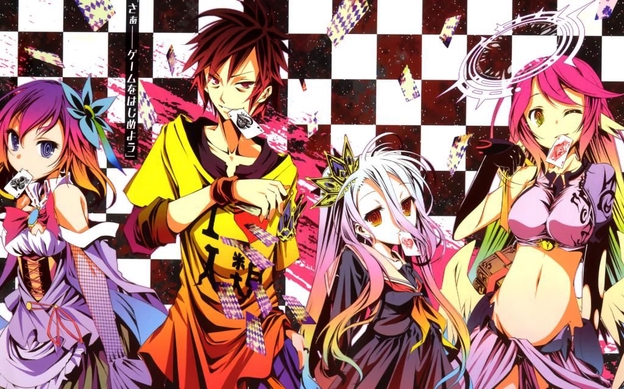
Let the games begin.
If I were ever so inclined to pursue a career in the animation industry, I think my dream job would be to work for Studio MADHOUSE. David Production may have unconditional love, UFOtable may have more money than God, but MADHOUSE is legendary, Alexander and Gilgamesh legendary (everything you’ve watched was already theirs!). With a pedigree a mile and a half long and a life span nearly twice your own, there’s a frighteningly high chance that it has had a hand in the the most memorable anime you’ve ever seen. With that legacy comes a high budget, a thoroughly comprehensive adaptation, intricately detailed animation, a glorious soundtrack, a production team with world-class dedication, and shows with only a single season, regardless of content size. With that information in mind when starting No Game, No Life, it’s comforting to know that what you’re seeing is a story fully realized.
Master gamer siblings Sora and Shiro, known in the gaming world only as 「 」, are doing PC Master Race things when a mysterious email challenges them to that classic game of perfect information: chess. Hours later, the duo wins the game, and as a reward for defeating Tet, the God of Play, they are immediately transported to Disboard, the world of the game board.
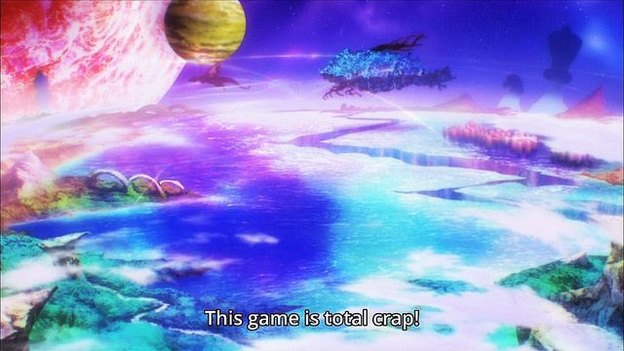
That feel when beta testing…
On Disboard there are 16 different sentient races known as Exceed, rated by their affinity for magic, making humans the weakest of all. However, this is a world where violence is forbidden, and all disputes (including national borders) are settled by gaming. The king of Elkia, the human kingdom, has just died, so a tournament is held to determine the new ruler of Imanity, humanity’s greatest gambler. Seeing as they have nothing better to do, Sora and Shiro win the tournament, become Imanity’s designated representatives, and begin a quest of global domination over all 16 Exceed races in order to challenge Tet for the title of One True God.

But first they need to figure out how to split a crown.
If ever there is a single word that comes to mind when thinking about No Game, No Life, it’s “fun.” The story is “fun.” The characters are “fun.” The artwork is “fun.” The games are “fun.” The show is simply fun, by God-given mandate.
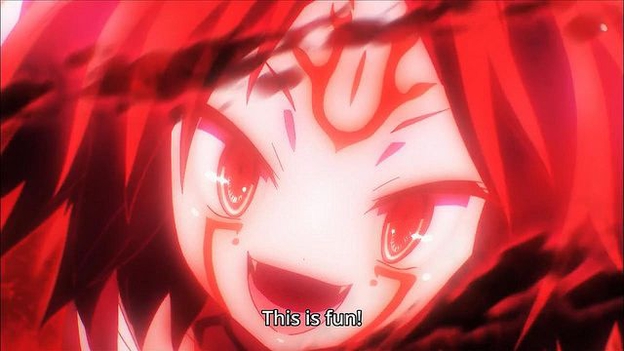
Even the cheating is fun!
When defending No Game, No Life’s position in the top spot, and I compelled to compare it to a similar show that beat this one to air: Problem Children Are Coming From Another World, Aren’t They? Both shows do follow the very similar premise of OP protagonists being summoned to a game-based reality where their team is in last place and they need to win the Pennant so that Daddy will come back, or am I just thinking of Angels in the Outfield? Well, while that may be very true, No Game, No Life has an interesting sub-clause outlined in Tet’s Ten Commandments: “Let us all get along and have fun.” Therefore, in order to challenge Tet to another chess match, Sora and Shiro have to not only defeat all Exceed races, they have to befriend them. This is in stark contrast to Problem Children, where the protagonists have to defeat country-destroying demon lords. Let’s face it: minions that hold hundreds of children hostage to force cities to lose games, all while having already eaten the children, don’t make for make for likeable characters or trustworthy allies. As such, everyone in No Game, No Life is likeable to at least some degree (they are typically female, by the way). Even the worst (quality-wise) characters work their way up to likeable eventually.

And how can anyone stay mad at something so precious?
The siblings themselves form a rather unique pair in anime. Though they have their own thoughts and feelings, they act as a unit. Not since Seventh have I seen a more charismatic unit in anime, and not since Master Blaster or the Blues Brothers have I encountered a duo with such drive towards a singular goal. Even in KILL la KILL, Senketsu acted more as a mentor to Ryuuko than a partner. Both Sora and Shiro are kind to a small extent, but they are also self-centered jerks to a lot of the cast. Fortunately, their social interactions with the beings of Disboard (up from zero in their own world) help to balance them out really well. Some may bemoan the fact that 「 」 is completely OP in many instances, but I would argue that in a world where humanity is on its very last legs, they have no access to magic whatsoever, and cheating is commonplace amongst all higher races, 「 」 kind of has to be just to stand a chance.
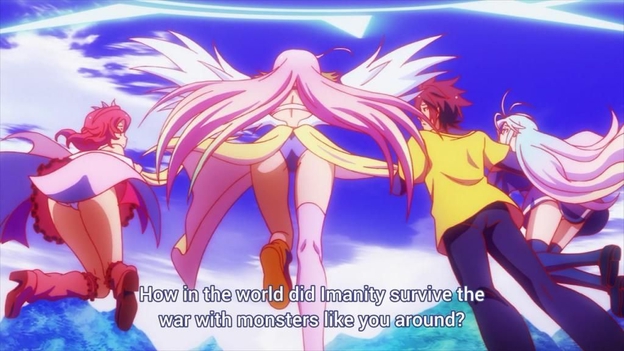
The question on everyone's lips.
I also happen to greatly enjoy the show’s main message about “the potential of humanity.” Yeah, I know that Manifest Destiny has been a corny message for nearly two centuries by now, but it still has a good deal of merit in our own world, and even more in No Game, No Life. Sora and Shiro have every right to hate humanity in their world (where both positive and negative social outliers are punished), and the Exceed of Disboard have every right to hate on humanity (which fails in their every metric). Yet it is Sora who constantly wears a shirt that says “I Love Humanity,” and it is Kurami that is considered the show’s worst character for often stating that “a weaker race cannot defeat a stronger race.” But why is that? Is it because our race is arrogant, since we already hold dominion over our own world, or is it because the idea that we can literally change our stars is so ingrained in our society that a mantra like Kurami’s seems ignorant? Well, with no access to magic, no way to prove that a higher race is cheating, no modern technology (Imanity is stuck in the Middle Ages, while the 14th ranked Werebeasts have skyscrapers and VR machines), and only one remaining city, Imanity doesn’t have an inspiring track record to disprove her statement. 「 」, on the other hand, are natural geniuses, hold the highest scores in everything ever, have seen all of humanity’s greatest achievements, and carry around tablet computers with enough data to make even a Flügel swoon. Seems a tad unfair to shit on Kurami and Stephanie for being bad at games, especially when they would make excellent power brokers in our own world.
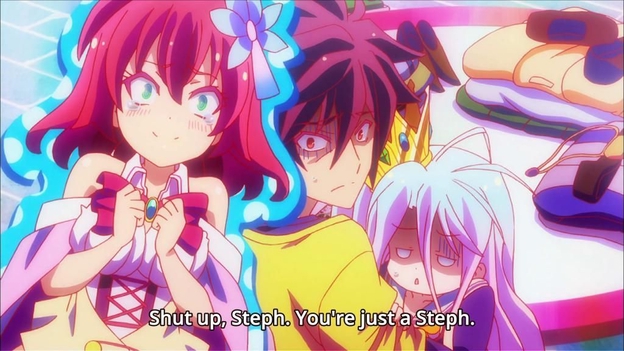
No Game, No Respect. No Respect at all.
Sora is the most cynical of them all, but all of his tactics and charm evaporate without his sister Shiro and her shining potential to guide them to victory. Kurami (and indeed, the rest of the kingdom of Elkia) comes around by the end of the show, but it does require 「 」 to lead by example. This leads to some really touching moments, which is especially rare, considering that this is a highly comedic show. For an anime based entirely in fantasy, it should feel comforting that the greatest creatures aren’t the ones with the most power, just the ones that are most clever.
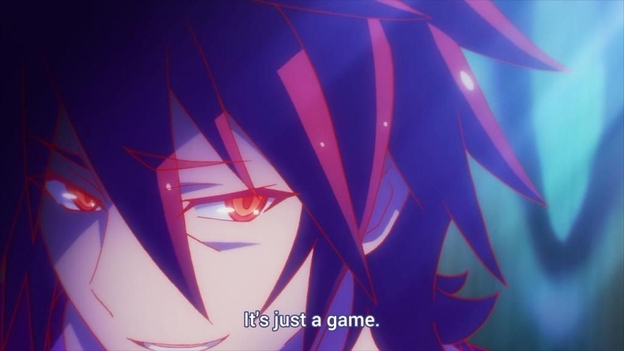
Or maybe the most psychopathic.
Of course, the main event in a show titled No Game, No Life is obvious the games, and they truly do take center stage. Every arc is a lengthy and elaborate setup to some truly memorable games. From MMO-style chess to world-warping word games to FPS dating sims, No Game, No Life elevates gaming to an entirely surreal level, and not without merit. Love, lives, national borders, and the extinction of one’s entire race can be waged on these games, and when the God of Play rules the world, the consequences of failure are very real and very binding. The stakes are always high with the arc-ending games, and the games are always entertaining, with at least a few funny moments in each. Each game provides a unique moment for characters to shine, and each opportunity is well taken.
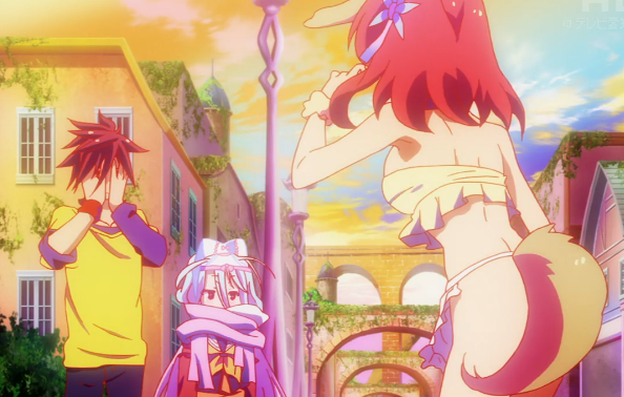
Well, some better than others.
2014 was a truly great year for anime, perhaps the best one in years. There were several great anime that began this year, with this list covering not even half of them (spoilers for 2015’s article). No Game, No Life, however, is the kind of show that only comes along every several years, the kind that lasts for only a moment, but stops you cold in your tracks to enjoy it. For as often as this show brought a smile for my face, someone whose enjoyment of anime has devolved to the point of appreciating only absurdity, despair, and excellence, I am truly hard-pressed to recommend a more memorable show than this.
Enjoy your New Year’s celebrations, and I’ll see you all back at Mines in 2015. There are still several top-tier anime concluding early next year, and many exciting new shows on the way. So whatever you do, don’t change that dial (or whatever you kids use to control those new-fangled internet boxes). Stay tuned!